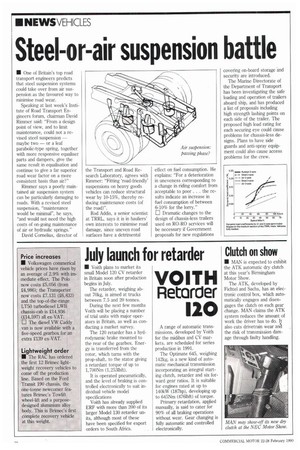Steel-or-air suspension battle
Page 12

If you've noticed an error in this article please click here to report it so we can fix it.
• One of Britain's top road transport engineers predicts that steel suspension systems could take over from air suspension as the favoured way to minimise road wear.
Speaking at last week's Institute of Road Transport Engineers forum, chairman David Rimier said: "From a design point of view, and to limit maintenance, could not a revised steel suspension — maybe two — or a leaf parabolic-type spring, together with more responsive equaliser parts and dampers, give the same result in equalisation and continue to give a far superior road wear factor on a more consistent basis than air?"
Rimmer says a poorly maintained air suspension system can be particularly damaging to roads. With a revised steel suspension, "maintenance would be minimal", he says, "and would not need the high costs of on-going maintenance of air or hydraulic springs."
David Cornelius, director of the Transport and Road Research Laboratory, agrees with Rimmer: "Fitting 'road-friendly' suspensions on heavy goods vehicles can reduce structural wear by 10-15%, thereby reducing maintenance costs (of the road)".
Rod Addis, a senior scientist at TRRL, says it is in hauliers' own interests to minimise road damage, since uneven road surfaces have a detrimental effect on fuel consumption. He explains: "For a deterioration in uneveness corresponding to a change in riding comfort from acceptable to poor . . . the results indicate an increase in fuel consumption of between 6-10% for the lorry."
0 Dramatic changes to the design of chassis-less trailers used on RO-R0 services will be necessary if Government proposals for new regulations
covering on-board storage 'and security are introduced.
The Marine Directorate of the Department of Transport has been investigating the safe loading and operation of trailers aboard ship, and has produced a list of proposals including high strength lashing points on each side of the trailer. The proposed high load rating for each securing eye could cause problems for chassis-less designs. Plans to have side guards and anti-spray equipment could also cause access problems for the crew.
















































































































































































